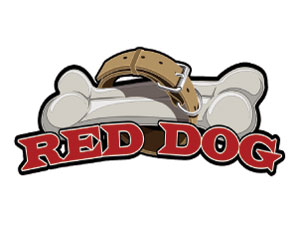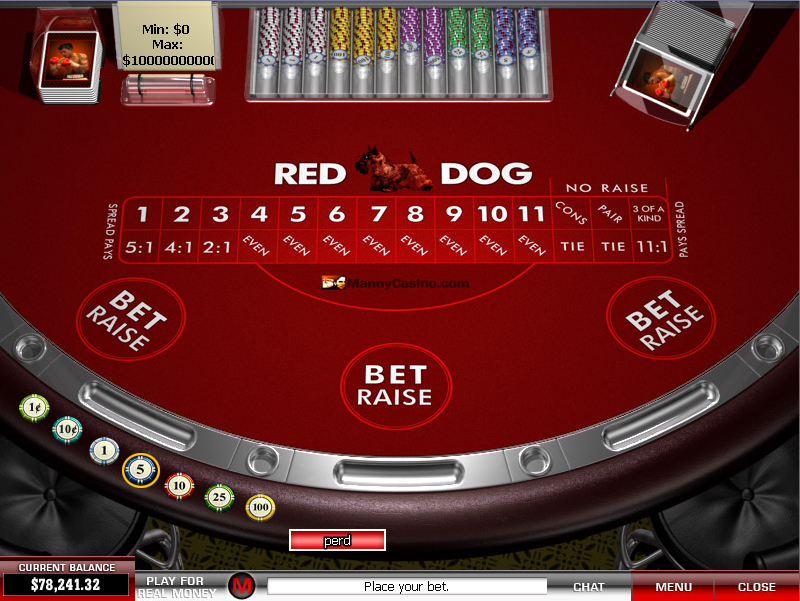
Nearly everyone grew up passing a deck of cards around the kitchen table with their family on rainy days, and one of the most popular home games ever played is known as Red Dog. In fact, Bicycle playing card brand includes a detailed rules section for players to use during home games between friends. Closely related to classic card games like acey deucy and in between, Red Dog gives players the chance to wager based on the spread between two randomly dealt cards.
The game feels like a hybrid of blackjack and casino war, with two cards being dealt out face up on each hand, followed by a third. Players want the value of the third card to land between the first two based on rank. When they do, escalating payouts are awarded based on the spread between the first two cards.
Red Dog provides the best of both worlds for casino game fans, combining the fun of pure guessing with a crucial decision on every hand, one which doubles the ante bet and the potential pay-out.
By consistently making the correct choice to either raise or simply call, you’re able to apply mathematical proficiency and natural card sense to transform Red Dog into a challenging game of skill. And like any of the great casino games, even when you make the best decision possible on a given hand, the deal of a single random card can swing fortunes in a flash.
While the sight of Red Dog tables in brick and mortar casinos has diminished over the years, the game is enjoying a renaissance within the world of online casinos. People all over the world have recently discovered Red Dog thanks to the power of online play, and today the game ranks as one of the more popular card based table games. So whether you’re preparing for your first Red Dog hand, or you’ve played the game since childhood, the following guide will familiarize you with the rules, game play, mechanics, and strategy of this home game favorite.
Top Casinos
How to Play
Red Dog is played using a standard 52 card deck of playing cards, although in most cases a shoe containing multiple decks is used. Some online casinos use a two-deck shoe while others use up to an eight deck shoe.
In Red Dog the cards are assigned their usual value based on rank, and aces are always high. The suit of each card is irrelevant.
The table is similar to most card-based table games, so you’ll see green felt lined with betting circles in front of you, and a lined grid in the middle. This grid features the numbers 1 through 11 in the top row, followed by the words consecutive, pair, and 3 of a kind. A series of blank squares sits underneath this row, followed by squares indicating payouts underneath each number or word.
The grid is typically shown as followed:
|
1 |
2 |
3 |
4 |
5 |
6 |
7 |
8 |
9 |
10 |
11 |
Cons. |
Pair |
3-Kind |
|
– |
– |
– |
– |
– |
– |
– |
– |
– |
– |
– |
– |
– |
– |
| 5:1 |
3:1 |
2:1 |
E |
V |
E |
N |
M |
O |
N |
EY |
PUSH |
PUSH |
11:1 |
A hand of Red Dog begins when you place a mandatory ante bet. After that, the dealer will flip two cards face up. The difference between these two cards is known as the spread, and in the event that a spread exists, the dealer will announce the number before marking it on the grid. Online casinos will simply mark the spread number with a graphic on the betting grid. The spread figure determines the payout for players on winning hands.
For example, when the dealer turns over a 3 and 9, the spread for this hand is set at 6 which pays out at 1 to 1 or even money. If the dealer reveals a 10 and a queen, however, the spread is set at 1 and winning bets are paid out at 5 to 1.
As the grid shows, whenever the two cards dealt out are consecutive (4 – 5, J – Q, K – A, etc.), your ante bet is simply pushed and returned. When the two cards are identical, forming a pair, a third card is dealt out and whenever three of a kind shows up on board, you bet is paid out at 11:1.
Consecutives and pairs are relatively rare though, and most hands will create a spread to give you a chance to make the game’s crucial decision: whether or not to raise or just call. Raising requires you to double the original ante bet, while calling keeps that first bet out and nothing more. In either case, the dealer will then deliver a third card face up.
Players want the third card to fall in between the first two cards to win their wager, while cards that fall outside of the two card range are considered losers. This is why the spread number is so important, and payouts escalate when the spread shrinks. Basic logic holds that smaller spreads (3 – 5, 5 – 8, etc.) will be harder win on, while larger spreads (3 – Q, 5 – A, etc.) will lead to easier wins.
As the player, your only choice is to assess the spread on board before deciding if you’d like to raise or just call. Obviously, when you see a large spread the right play is to raise, and small spreads are best played with just a call, but hands that provide marginal spreads right on the edge give the game its gusto. When you throw in the escalating payouts based on the spread amount, Red Dog becomes a game of targeted risk taking that can provide plentiful rewards.

Proper Strategy
Red Dog is such a simple game that it may not seem like strategy comes into play, but the elegance of partial information and single decision card games makes all the difference.
The first thing to keep in mind if you want to improve your overall edge in Red Dog is the size of the shoe being used. In blackjack, the addition of more decks to the shoe increases the house edge, but in Red Dog players are the ones who benefit from more decks being put in play. With one deck being used the house enjoys an edge of 3.155 percent, but adding one more deck drops that number to 3.077 percent. A four deck shoe offers the house an edge of 2.884 percent, a six deck shoe reduces that to 2.798 percent, and an eight-deck shoe creates a 2.751 percent house edge.
So the choice is clear: whenever possible, play with multiple deck shoes to increase your expected value.
As far as the strategic concerns to keep in mind when playing Red Dog, the game can actually be boiled down into mathematical rules. The table below illustrates the win probabilities and player’s edge for every possible spread in play:
EXPECTED GAIN BY RAISING
| Spread | Pays | Win Prob. | Ex. Value |
|---|---|---|---|
| 1 | 5:1 | 0.077419 | -0.535484 |
| 2 | 4:1 | 0.154839 | -0.225806 |
| 3 | 2:1 | 0.232258 | -0.303226 |
| 4 | 1:1 | 0.309677 | -0.380645 |
| 5 | 1:1 | 0.387097 | -0.225806 |
| 6 | 1:1 | 0.464516 | -0.070968 |
| 7 | 1:1 | 0.541935 | 0.083871 |
| 8 | 1:1 | 0.619355 | 0.238710 |
| 9 | 1:1 | 0.696774 | 0.393548 |
| 10 | 1:1 | 0.774194 | 0.548387 |
| 11 | 1:1 | 0.851613 | 0.703226 |
As you can see by the data depicted above, the only times raising becomes a profitable play is when the spread totals 7 or above. Therefore, optimal strategy for Red Dog is simply to call on all spreads of 6 and lower, while raising on all spreads of 7 and higher.






